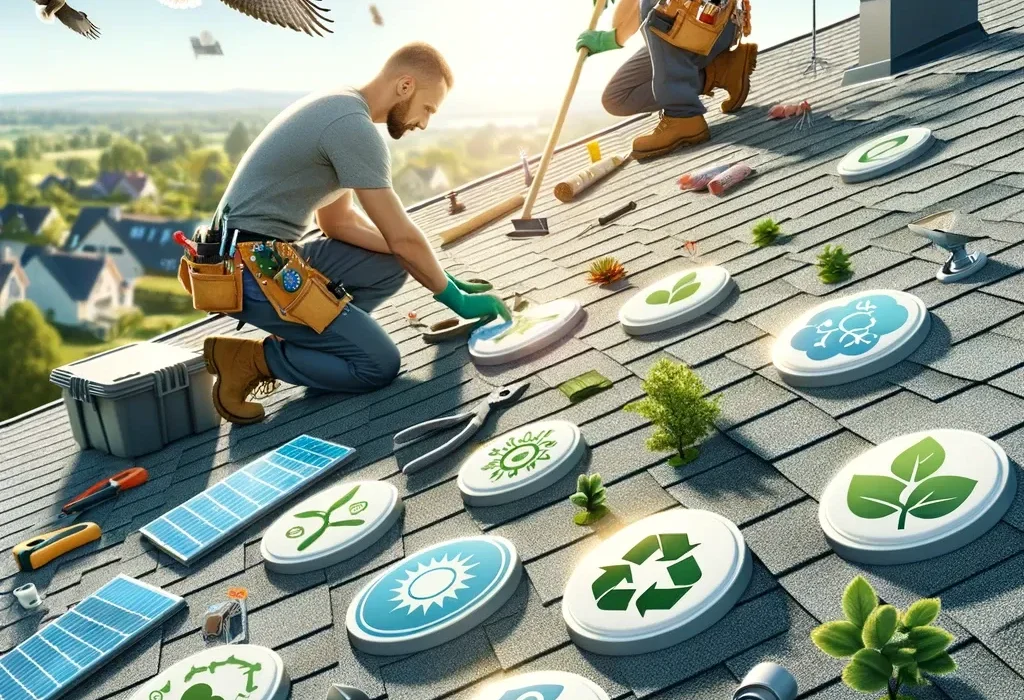- By Austin's 1# Roofing Pros
- Guides
- 0 Comment
Introduction to Sustainable Roofing
In the modern era, where environmental conservation is paramount, eco-friendly roofing is crucial to sustainable living. Austin Roofing Company provides an in-depth guide to understanding and implementing sustainable roofing solutions. This guide explores how roofing choices can significantly impact environmental health and improve energy efficiency.
Embracing Eco-Friendly Roofing in Texas
Texas’ varied climate, characterized by intense heat and occasional severe weather, offers an ideal setting for sustainable roofing. Such roofing solutions enhance your home’s energy efficiency and significantly contribute to environmental conservation. In Texas, where there is high cooling demand, eco-friendly roofing can save energy and reduce your carbon footprint.
Types of Sustainable Roofing Materials
- Cool Roofs: These roofs reflect more sunlight, reducing heat absorption. In Texas’ hot climate, cool roofs can significantly reduce air conditioning needs, contributing to energy savings and comfort.
- Recycled Shingles: Utilizing recycled materials, these shingles demonstrate sustainable practices, reducing landfill waste and conserving resources
- Metal Roofing: This option is celebrated for its durability and recyclability. Metal roofs are energy-efficient, reflect heat, and last up to 50 years.
- Green Roofs: Comprising vegetation, green roofs offer natural insulation, improve air quality, and manage stormwater effectively. They are particularly beneficial for combating the urban heat island effect in urban settings.
- Solar Roofs: These roofs integrate solar panels directly into roofing materials, enabling homeowners to generate clean energy. Solar roofs have evolved to be more versatile and aesthetically appealing, making them a viable option for homeowners seeking sustainability and curb appeal.
Benefits of Eco-Friendly Roofing
- Energy Efficiency: Sustainable roofing materials offer improved insulation and reflectivity, leading to substantial energy savings. For example, cool roofs can reduce cooling expenses by up to 30%.
- Environmental Impact: By choosing eco-friendly materials like recycled shingles or green roofs, homeowners contribute to waste reduction and biodiversity enhancement
- Durability and Longevity: Sustainable roofing solutions are typically more durable than conventional options. Materials like metal roofing and recycled shingles last decades, reducing roof replacement frequency.
Implementing Sustainable Roofing in Texas
When considering sustainable roofing in Texas, several key factors come into play to ensure your choice is environmentally friendly. However, it is also practical and efficient.
- Climate Suitability: Selecting roofing materials that can withstand the harsh Texas climate, from intense heat to heavy storms, is crucial. Cool roofs, for example, are particularly beneficial in hot areas for their ability to reflect sunlight and reduce indoor cooling requirements.
- Professional Installation: Proper installation by experienced professionals like Austin Roofing Company is essential. Incorrect installation can undermine the efficiency and longevity of the roofing material.
- Maintenance and Longevity: Understand the specific maintenance needs of your chosen eco-friendly roofing. For instance, green roofs may require more upkeep, but their environmental benefits and energy savings can be substantial.
Overcoming Challenges and Misconceptions
- Cost Analysis: Initial installation costs of sustainable roofing options are often higher than traditional materials. However, long-term energy efficiency, durability savings, and possible tax incentives can offset these initial costs.
- Grants and Incentives: Look at federal and state incentives that can reduce the upfront cost of installing sustainable roofing. Programs like the Investment Tax Credit (ITC) can offer significant deductions.
Global and Regional Movements in Sustainable Roofing
The adoption of sustainable roofing is a worldwide movement, with different regions contributing distinct approaches and technologies:
- Europe’s Leadership in Sustainable Roofing: Europe’s robust regulations and stakeholder commitment to sustainable construction have increased eco-friendly materials and energy-efficient designs.
- North America’s Green Roofing Initiatives: The emphasis on green roofs is growing, driven by their ability to combat urban heat islands and manage stormwater effectively.
- China’s Investment in Sustainable Infrastructure: China’s focus on incorporating advanced roofing technologies in new developments is a testament to its commitment to sustainable strategies.
Policy, Regulation, and Government Role
Governmental actions and regulations shape the roofing industry’s approach to sustainable development:
- Government Incentives and Regulations: Tax credits and rebates can significantly reduce the cost of a sustainable roof. Building codes incorporating sustainability standards ensure roofing practices contribute to broader environmental goals.
Conclusion: Paving the Way for a Sustainable Future with Roofing
Adopting sustainable roofing solutions is a significant step towards reducing your home’s environmental impact. By choosing eco-friendly options, you’re contributing to a greener future. Austin Roofing Company is committed to guiding homeowners in Texas through selecting and installing sustainable roofs. This ensures that the process is environmentally friendly and economical.
Interested in sustainable roofing for your Texas home? Contact Austin Roofing Company to explore eco-friendly options that align with your vision for a sustainable future. Together, we can make informed choices that benefit your home and the environment.

